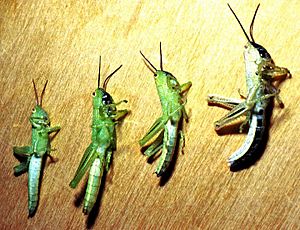Hieroglyphus daganensis facts for kids
Quick facts for kids Hieroglyphus daganensis |
|
|---|---|
 |
|
| H. daganensis male & female | |
| Scientific classification | |
| Synonyms | |
|
H. abbreviata Krauss, 1877 |
The African rice grasshopper, known scientifically as Hieroglyphus daganensis, is a medium-sized grasshopper. You can find it in the Sahel region of Africa.
Even though it's not called a locust, this grasshopper can act like one. When many of them gather together, they show "gregarious behavior." This means they like to live in groups. They can also change their body shape and color slightly when crowded. This change is called "phase polymorphism." Because of this, they can become a problem, or "pest," for small farms in the area.
Contents
About the African Rice Grasshopper
What Adults Look Like
Adult African rice grasshoppers are usually green. Their skin looks shiny and has tiny dots. Their antennae are longer than their head and the part of their body behind the head, called the pronotum, put together. The pronotum is shaped like a cylinder. It has three deep grooves that cross its back.
Young Grasshoppers (Hoppers)
The color of young grasshoppers, called nymphs or hoppers, can change. This depends on how many other grasshoppers are around them. For example, during a year when many H. daganensis were born, crowded groups of young grasshoppers turned darker in certain areas of their bodies. This is a sign of their "phase polymorphism."
Outbreaks and How to Control Them
Outbreaks of the African rice grasshopper happen often in countries in the Sahel region. These include Senegal, Mauritania, Burkina Faso, Mali, Niger, and Benin. This grasshopper has also been found as a pest of sorghum crops in India.
Farmers can use a special product called 'Green Muscle' to help control these grasshoppers. This product is a biological pesticide. It uses a natural entomopathogenic fungus called Metarhizium acridum. This fungus can make insects sick. Early tests of 'Green Muscle' worked well in northern Benin. The LUBILOSA Programme tested it on H. daganensis in the field.
Grasshoppers as Food
Some people eat the African rice grasshopper! The Northern Dogon people who live in the Mopti Region of Mali consume this species as part of their diet.
See also
 In Spanish: Saltamontes africano del arroz para niños
In Spanish: Saltamontes africano del arroz para niños


